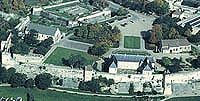![]() Caen,
capital of western Normandy
Caen,
capital of western Normandy
 After the battle of Val-ès-Dunes,
Duke William needed to assert his power more firmly in the western part of the
Duchy and use a fortified town as a base. His choice was Caen which was still
no more than an emerging centre of population to which Richard II had granted
certain privileges. Acts promulgated by William's ancestors, Richard II and
Richard III, indicate a large rural domain (villa), vineyards, meadows,
windmills and also churches and a port, but as yet no urban structure.
After the battle of Val-ès-Dunes,
Duke William needed to assert his power more firmly in the western part of the
Duchy and use a fortified town as a base. His choice was Caen which was still
no more than an emerging centre of population to which Richard II had granted
certain privileges. Acts promulgated by William's ancestors, Richard II and
Richard III, indicate a large rural domain (villa), vineyards, meadows,
windmills and also churches and a port, but as yet no urban structure.

 William had founded a church
in Caen, Sainte-Paix (1061), in honour of the Council held there after his victory at
Val-ès-Dunes (1047). He gave the town its true birth, however, by building a great
castle there on which work began in c. 1050.
William had founded a church
in Caen, Sainte-Paix (1061), in honour of the Council held there after his victory at
Val-ès-Dunes (1047). He gave the town its true birth, however, by building a great
castle there on which work began in c. 1050.
The foundation of two abbeys confirmed the new importance that the Duke wished to give the town. They also reinforced the marriage vows of William and Matilda in exchange for the lifting of the interdict on their marriage. The work on the Abbaye aux Dames, a foundation of Matilda's began in 1059; and the work on the Abbaye aux Hommes, William's foundation began in 1065.
 The ducal town, at the foot of the
castle, and the two abbey towns were the kernels around which Caen was to
develop. From the time of William, a palace complex was erected in the castle
to receive the Duke and his itinerant court. The political and administrative
functions, extended by his successors, sustained the development of the town,
which was well located at the crossroads of the Duchy and whose port was to
benefit from the conquest of England.
The ducal town, at the foot of the
castle, and the two abbey towns were the kernels around which Caen was to
develop. From the time of William, a palace complex was erected in the castle
to receive the Duke and his itinerant court. The political and administrative
functions, extended by his successors, sustained the development of the town,
which was well located at the crossroads of the Duchy and whose port was to
benefit from the conquest of England.
Based in Rouen and Caen, William from this point onwards had a firm grip on the entire Duchy.